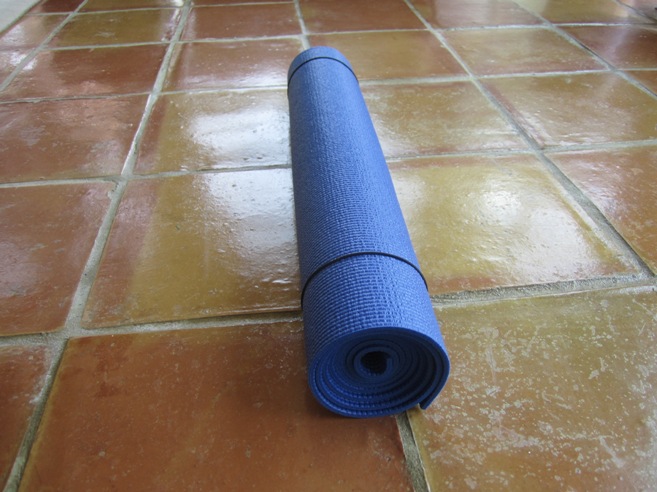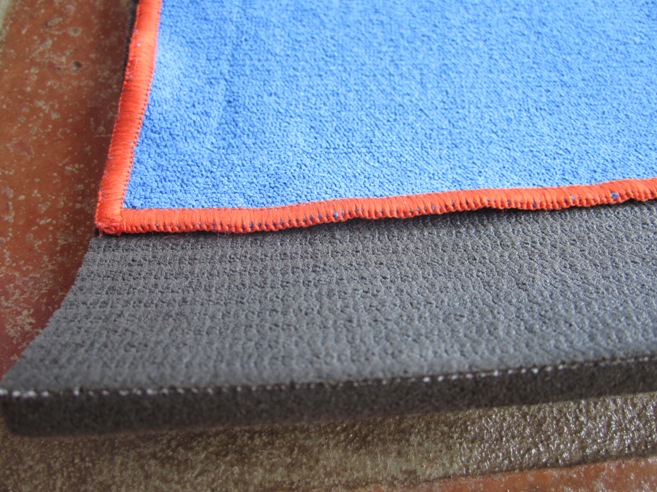
If I had a quarter for every time I tried to explain to some high end club I work that you need to choose the right equipment for the right exercise, I would be a rich woman.
The wrong yoga mat is a bit like skiing with badly fitting boots. And the wrong mat altogether is like trying ski with a snowboard.
I’ve seen it a million times. Someone musters up the gumption to show up to their very first yoga class at their elite “members only” club, only to be handed one of the following: a stretching mat, a Pilates mat or a stinky, thin and slippery cheap yoga mat.
It never ends well, and the frustration is all over their face. I can’t tell you how many times I have loaned out my own mat in a desperate attempt to save them from a lifetime of hating yoga.
It’s not always much better at the yoga studios. Studio mats are usually not top of the line & are rarely cleaned properly. Some more savvy newbies, bless their hearts, even come toting their own shiny new mat. But they too will end up hating yoga, as soon as their hands and feet start slipping out from underneath them, leaving them red faced from a mixture of embarrassment, and sheer effort to keep ending up spread eagle on the floor.
For a yoga lover, it’s heart breaking, really. Because the truth is, whether or not you enjoy yoga is directly related to the surface you choose. For those of you who haven’t thrown in the towel yet, read on to learn a bit more about what you need to consider when choosing the right yoga mat for you.
Cushion
While it is possible to do yoga with no mat at all, for most people a thick mat can make all the difference to the comfort of bones and joints. Certain postures and movements can be painful without sufficient cushion, so if you are beginner, your best bet is to choose a mat with a sufficient thickness.
But wait! Cushion isn’t enough. If cushion is your only criteria, you may find yourself buying a Pilates mat or a stretching mat, both totally unsuitable for any type of yoga that requires you to balance on your hands and feet (i.e. Standing on two feet or assuming a downward dog position).
Firmness
The thickness of the cushion isn’t enough. Mats also need to to have a firmness, so that when you pinch it between two fingers, the material does not sink too much. Yoga mats should retain the cushion under pressure.
Traction
Many mats, especially the ones that look vibrant, are slippery. Look for mats with a matte color, versus a sheen, or consider using a yoga towel or rug on top to give you better traction.

The above is an image of a typical cheap mat, which is usually under $30. Notice the sheen and the texture, which can make it quite slippery, especially if your hands and feet tend to sweat. It’s thin with poor cushion and firmness, and it will soak water and bacteria like sponge from the sides, and after a few uses from the top as well.
Drying Time
Mats are closed-cell or open-cell mats. Open-cell mats are more porous, which makes them less slippery, but less hygienic, as they absorb water and sweat and trap it inside. The more porous your mat, the longer the drying time (easily 24 hours hanging indoors to dry).
Even some closed cell mats, like the one pictured above are open cell on the sides. Additionally the closed cell surface is quickly eroded away. Ultimately you might as well consider this style of mat to be open cell as well.
For me, this has always been the reason I cannot offer yoga mats to my students. I run a beach-side seasonal yoga studio in India, with no modern luxuries like washing machines and dryers. The only mats available to me are cheap mats, which are essentially the same thing as sponges. Washing and drying mats before the next day’s classes is simply not possible. In my studio, I have had to learn how to teach students to practice without a mat if they choose not to buy one, simply because washing and drying mats for students is just not a hygienic option.
Washability
If you’ve never done yoga before, you’ve never had the pleasure of getting a horrifying whiff of your neighbors stinky yoga mat. Most mats, especially cheap ones, are porous. Bacteria resides in those pores. Without a soap and water scrub, or soaking the mat in a proven disinfectant, there is just no getting rid of bacteria and viruses hiding in the pores of a yoga mat.
Portability
Consider how long you will need to have your mat on your shoulder, or if you ride a bike, how you will attach it to your bicycle. Unless you drive to yoga, a light weight mat is going to be much easier to transport. Chances are your favorite yoga mat will reek havoc on your neck and shoulders if you carry it for a while. And if you are a traveler, like me, prepare to sacrifice half your luggage to accommodate your new baby in your suitcase to stay under the airline luggage weight limits—something I’ve done more times than I care to admit.
Length and Width
Not all mats are the same height and width. If you are very tall and very broad shouldered, look for an extra long mat (81 inches) and and extra wide mat (36 inches). Fair warning, if you are not particularly tall, you are going to piss off those around you if you show up to yoga class with an unnecessarily large mat in and attempt to maximize your personal space.
As tempting as it is to maximize your personal space, creating a barrier between you and the hairy sweaty guy beside you, these mats are meant for tall people only. Believe me, it is one of those unspoken yoga rules that will get you plenty of dirty looks if you ignore.
Typical stretchings mat found in gyms and clubs are much too short for yoga, and offer zero traction on a floor. And even though they have closed cell surfaces, even the elite clubs never wash them. I speak from experience. They are hands down the worst choice for yoga classes.

Material
The most common materials used to construct yoga mats are PVC and phthalates, both destructive to the environment and human health (with sufficient exposure). PVC mats do not biodegrade and are not recyclable. If you are looking for a more environmentally friendly option, look for mats made from cork, jute (or other plant fibers), as well as biodegradable, recyclable compounds like polymer environmental resin (PER) and thermoplastic elastomer (TPE).
An eco-mat will not last you as long, and most will shed more than a fat Old English Sheepdog. And don’t get me started on the chunks of colored residue under your toenails.
If decorating your hands and feet like Christmas ornaments in the name of the environment doesn’t appeal to you, consider a cloth mat. Although it’s difficult to find an eco-friendly cloth mat, they are out there if you are willing to pay a bit more for an organic cotton mat.
Cloth mats are usually pure cotton, or a combination of cotton with rubber dots on the underside. Both styles work best the wetter they are, so they are best suited to someone who sweats a lot in yoga, especially in the hands and feet.
Other advantages to cloth mats are they are lightweight, easy to wash and dry, and provide great traction. What’s more, it means your cheap, slippery mat doesn’t need to become a bacteria farm after all! Layer a cloth mat over it and you have a sanitized surface with great traction.
The verdict:
The best combination: a closed cell mat with washable cotton mat on top. You can’t go wrong, and it’s almost guaranteed to last you a lifetime. Your back up plan if you’ve already bought a cheap mat or an eco-mat? Layer the cloth mat on top. Using a yoga towel or rug on top will create a barrier, prolonging the life of your quick to erode eco-friendly mat. It will protect you from the bacteria that love to make homes in those open cell surfaces, and best of all, you won’t end up face planting in downward dog because you’re sliding all over the place.
Relephant:
How to Give Your Old Yoga Mat an Afterlife.
Author: Sarah Keeley
Editor: Catherine Monkman
Photos: Author’s Own











Read 1 comment and reply